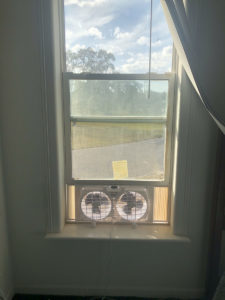 Existing evidence strongly suggests that viral infectious diseases can be transmitted via an airborne route across distances in indoor environments. Accordingly, the risk of airborne transmission within homes should be managed. The public health emergency associated with SARS-CoV-2 makes controlling airborne transmission of respired viruses in indoor environments critical, especially in poorly ventilated indoor environments. The effectiveness of engineering interventions requiring minor efforts that create a negative-pressure isolation zone for a contagious person has yet to be tested for existing residential homes. To mitigate the risk of airborne virus transmission and maximize health protection for the population in existing single-family homes, this report investigates the relative effectiveness of several control strategies. Although very high-efficiency MERV filtration, high ventilation rates, and other controls can help be effective, most occupants are not likely to have the time or means for advanced measures found in hospitals. This project focuses on relatively simple efforts that utilize existing or easy to acquire materials and straightforward processes.
Existing evidence strongly suggests that viral infectious diseases can be transmitted via an airborne route across distances in indoor environments. Accordingly, the risk of airborne transmission within homes should be managed. The public health emergency associated with SARS-CoV-2 makes controlling airborne transmission of respired viruses in indoor environments critical, especially in poorly ventilated indoor environments. The effectiveness of engineering interventions requiring minor efforts that create a negative-pressure isolation zone for a contagious person has yet to be tested for existing residential homes. To mitigate the risk of airborne virus transmission and maximize health protection for the population in existing single-family homes, this report investigates the relative effectiveness of several control strategies. Although very high-efficiency MERV filtration, high ventilation rates, and other controls can help be effective, most occupants are not likely to have the time or means for advanced measures found in hospitals. This project focuses on relatively simple efforts that utilize existing or easy to acquire materials and straightforward processes.
Videos
A video showing how to set up the ideal isolation space to contain an infectious disease: https://vimeo.com/557714520.
A presentation, Approaches for Effective Isolation Space Control to Minimize Airborne Transmission of Contaminants in Residential Homes, presented by UCF researcher Tanvir Khan, PhD as a webinar for the Energy & Environmental Building Alliance: https://vimeo.com/569436332
Publications
The research results are published at:
Fact sheet: https://www.nrel.gov/docs/fy21osti/79519.pdf
Full report: https://www.nrel.gov/docs/fy21osti/79516.pdf
UCF researchers also conducted a separate, in parallel study with four containment controls in an occupied single-family home under various operating conditions.
Journal article: https://www.mdpi.com/1660-4601/18/11/5880
Sponsor
U.S. Department of Energy, National Renewable Energy Laboratory
Research Period: 2020–2021